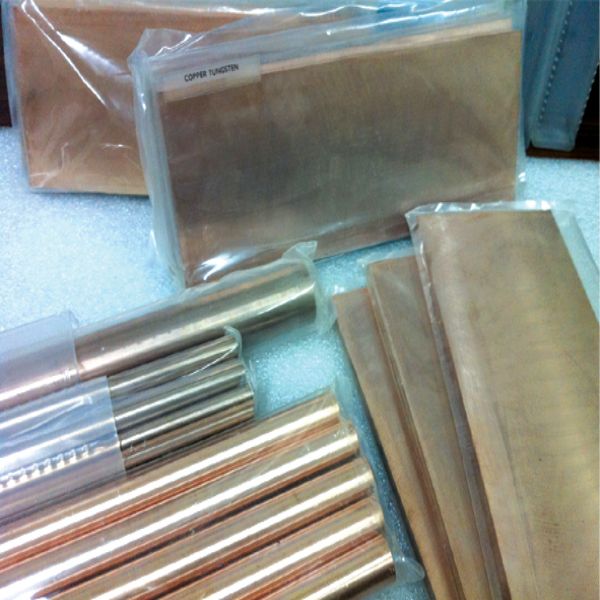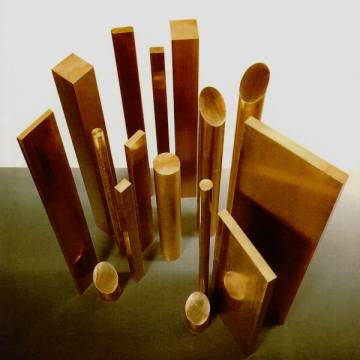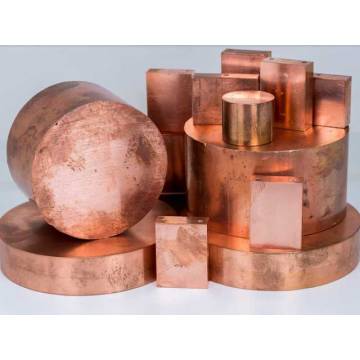Copper
Copper Tungsten (CuW)
Specifications
- Cu25W75
Summary
- Copper Tungsten alloys are used where the combination of high heat resistance, high electrical and thermal conductivity, and low thermal expansion are needed.
- Some of its applications are electric resistance welding, electrical contacts, as well as heat sinks.
- Used extensively in engineering, electrical and electron industries as well as in metallurgy and in aviation.
- Combining advantageous attributes of high conductivity of copper and low expansive property of tungsten, it is highly suitable for use in dense circuits and high voltage electrical devices, heat sinks, electrical contacts and electrodes.
- Widely used in chip carriers, substrates and frames for power and semiconductor devices.
Introduction:
Copper tungsten, also known as copper-tungsten alloy, is a composite material composed of copper and tungsten. This unique alloy combines the excellent electrical and thermal conductivity of copper with the high melting point, hardness, and wear resistance of tungsten. Copper tungsten alloys are widely used in various industries, including aerospace, automotive, electronics, and defense, where they offer unparalleled performance in demanding applications. Understanding the properties, applications, and manufacturing processes of copper tungsten is crucial for engineers and manufacturers seeking superior material solutions.
Properties of Copper Tungsten:
- High Thermal Conductivity: Copper tungsten alloys exhibit excellent thermal conductivity, making them suitable for heat sinks, electrical contacts, and other applications requiring efficient heat dissipation.
- High Electrical Conductivity: While not as conductive as pure copper, copper tungsten still maintains good electrical conductivity, ensuring reliable electrical connections in high-current applications.
- High Melting Point: Tungsten, with one of the highest melting points of all metals, significantly enhances the alloy's thermal stability and resistance to elevated temperatures.
- Hardness and Wear Resistance: The addition of tungsten enhances the hardness and wear resistance of copper tungsten, making it suitable for applications subject to friction, abrasion, and mechanical stress.
- Low Thermal Expansion: Copper tungsten exhibits low thermal expansion characteristics, ensuring dimensional stability over a wide range of temperatures.
- Corrosion Resistance: Copper tungsten alloys are inherently resistant to corrosion, enhancing their longevity and reliability in harsh environments.
Applications of Copper Tungsten:
- Electrical Contacts: Copper tungsten is widely used in electrical contact materials for switches, relays, circuit breakers, and other electrical components requiring high conductivity, low contact resistance, and wear resistance.
- Heat Sinks and Electronic Packaging: Due to its excellent thermal conductivity, copper tungsten is employed in heat sinks, electronic packaging, and thermal management solutions for dissipating heat generated by electronic devices and power electronics.
- Resistance Welding Electrodes: Copper tungsten electrodes are utilized in resistance welding applications, where they offer high thermal conductivity, hardness, and wear resistance, ensuring consistent and reliable welds in manufacturing processes.
- Aerospace and Defense: Copper tungsten alloys find applications in aerospace and defense industries for components such as rocket nozzles, electrical connectors, electrodes, and radiation shielding due to their high performance under extreme conditions.
- Oil and Gas Industry: In the oil and gas industry, copper tungsten is utilized in drilling and exploration equipment, valves, and instrumentation where high strength, wear resistance, and corrosion resistance are required.
Manufacturing Process:
The manufacturing of copper tungsten involves several processes:
- Powder Metallurgy: One common method involves mixing powdered copper and tungsten, followed by compacting and sintering the mixture at high temperatures to form a solid alloy.
- Infiltration: In some cases, tungsten is infiltrated into a porous copper matrix, resulting in a dense copper tungsten composite with controlled tungsten content.
- Extrusion, Rolling, or Forging: The alloy may be further processed through extrusion, rolling, or forging to achieve the desired shape, dimensions, and mechanical properties.
- Heat Treatment: Copper tungsten may undergo heat treatment processes to enhance its properties, such as hardness and dimensional stability.
Conclusion:
Copper tungsten alloys offer a unique combination of properties, including high thermal and electrical conductivity, high melting point, hardness, and wear resistance, making them indispensable in numerous high-performance applications across various industries. By leveraging the exceptional characteristics of copper tungsten, engineers and manufacturers can develop innovative solutions for demanding environments where reliability, durability, and efficiency are paramount.
Share






